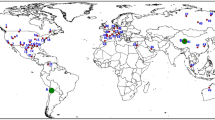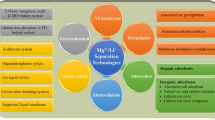Abstract
Prices for battery-grade lithium have increased substantially since 2020, which is propelling the search for additional sources of this important element. Battery-grade lithium is predominately recovered from continental brines. Most crude oil and natural gas wells recover briny formation water, which may represent an additional source. Chemical analysis of these waters has been shown to indicate the presence of varying concentrations of lithium and related elements. This paper briefly reviews developments and literature supporting the presence of lithium in petroleum reservoir brines. It also describes the coverage and distribution of lithium data analyses in the United States Geological Survey National Produced Waters Geochemical Database (PWGD). It then addresses the question as to whether a lithium concentration can be accurately predicted using constituents of ion chemistry in produced brines from specific geologic formations. Four machine learning algorithms are employed to classify the commercial potential of lithium in oil field brines using data from oil wells recovering formation water from the Smackover Formation. The calibrated classification models are further applied to new (out-of-sample) data from the Marcellus Formation in the Appalachian Basin. Among the approaches considered, the predictive performance and wider applicability of the gradient boosted tree and the deep neural network models are determined to be the most promising. Finally, we discuss how the calibrated models could be applied to assure the quality of the data reported from chemical laboratory analysis and for imputation when lithium values are missing.








Similar content being viewed by others
Data Availability
Data are accessible at the United States Geological Survey National Produced Waters Geochemical Database. See the following data release Blondes, M. S., Gans, K. D., Engle, M. A., Kharaka, Y. K., Reidy, M. E., Saraswathula, V., Thordsen, J. J., Rowan, E. L., and Morrissey, E. A. (2018). U.S. Geological Survey National Produced Waters Geochemical Database (ver. 2.3, January 2018): U.S. Geological Survey data release, https://doi.org/10.5066/F7J964W8.
Notes
A resource whose location, grade, quality, and quantity are known or can be estimated from specific geologic evidence.
The provinces are based on the American Association of Petroleum Geologists’ classification scheme (Meyer et al. 1991).
For 112 Smackover Formation samples from unique wells with complete predictor records used in this analysis the mean lithium concentration is 178 mg/l.
It was reported by the Wall Street Journal (Morene and Eaton 2023) that ExxonMobil had spent $100 million for Smackover Formation mineral rights for 120,000 acres near the town of Magnolia, Arkansas, for a lithium recovery project.
Smackover brine wells associated with a bromine recovery project had median monthly production of about 470 hundred thousand barrels (S&P Global 2023).
Additional predictors of calcium and magnesium concentration were examined but added no new information to these five predictors.
The theory that the lithium was sourced from rocks of Alleghenian origin and released to the Smackover via the Norphlet Formation is reported in Daitch (2018).
The classification problem was also analyzed with a logistic regression model. The classification performance was inferior to all machine learning algorithms examined in this paper.
An activation or neuron in a neural network is a mathematical function that collects and classifies information according to a specific architecture. Activation functions determine a neuron should be activated by computing the weighted function of inputs values (from the adjacent layer) and adding a bias term. The effect is to introduces non-linearity into the neuron output (James et al. 2021).
For cross-validation, the training data are divided into multiple folds, with one of the folds designated as a validation set, and the model is trained on the remaining folds. This process is repeated multiple times, each time a different fold is used as the validation set. The performance measures from each of the validation folds are averaged to estimate the model’s predictive performance when new data are applied.
The term “maximum accuracy” is used here to align how other researchers use it and software reports it. If c is correctly classified (as either true or false) and n is the sample size, it is max accuracy in percent = 100 × c/n. The average error rate is the average of the error rate of those true that were classified as false (ft) divided by total number true (nt) and those that were classified as false that were true (tf) divided by the total number of false (nf), so average error rate is equals 100 × 0.5 × [(ft/nt) + (tf/nf)].
The specificity measure is important when one is concerned with detecting below the cutoff and there is a high cost associated with misclassifying a sample at or above the cutoff. Sensitivity is important when cost of a false positive (labeling as positive when is not true) is low.
References
Arkansas Geological Survey (2020) https://www.geology.arkansas.gov/minerals/industrial/bromine-brine.html. Accessed July 2022
Baldwin S (2022) Inflation reduction act benefits: electric vehicle tax incentives for consumers and U.S. automakers. Forbes, September 7, https://www.forbes.com/sites/energyinnovation/2022/09/07/inflation-reduction-act-benefits-electric-vehicle-tax-incentives-for-consumers-and-us-automakers/?sh=19233bc0117e. Accessed Sept 2022
Blondes MS, Gans KD, Engle MA, Kharaka YK, Reidy ME, Saraswathula V, Thordsen JJ, Rowan EL, Morrissey EA (2018) U.S. Geological Survey National Produced Waters Geochemical Database (ver. 2.3, January 2018): U.S. Geological Survey data release, https://doi.org/10.5066/F7J964W8
Bradley D, Munk L, Jochens H, Hynek S, Labay K (2013) A preliminary deposit model for lithium brines: U.S. Geological Survey Open-File Report 2013–1006 6. https://doi.org/10.3133/ofr20131006
Bradley DC, Stillings LL, Jaskula BW, Munk L, McCauley AD (2017) Lithium (Chap. K), in Schulz KJ, DeYoung JH Jr, Seal RR II, and Bradley DC eds., Critical mineral resources of the United States—economic and environmental geology and prospects for future supply: U.S. Geological Survey Professional Paper 1802, p. K1– K21, https://doi.org/10.3133/pp1802K
Breiman L (2001) Random forests. Mach Learn 45:5–32. https://doi.org/10.1023/A:1010933404324
Breiman L, Friedman JH, Olshen RA, Stone CJ (1984) Classification and regression trees, Wadsworth, Inc., p. 358. https://books.google.com/books/about/Classification_and_Regression_Trees.html?id=JwQx-WOmSyQC
Candel A, LeDell E (2023) Deep learning with H2O, 6th Ed. H2O.AI Inc., 55. https://www.h2o.ai/resources/booklet/deep-learning-with-h2o. Accessed Aug 2023
Capo RC, Stewart BW, Rowan EL, Kolesar Kohl CA, Wall AJ, Chapman EC, Hammack RW, Schroeder KT (2014) The strontium isotopic evolution of Marcellus Formation produced waters, southwestern Pennsylvania. Int J Coal Geol 126:57–63. https://doi.org/10.1016/j.coal.2013.12.010
Chapman EC, Capo RC, Stewart BW, Kirby CS, Hammack RW, Schroeder KT, Edenborn HM (2012) Geochemical and strontium isotope characterization of produced waters from Marcellus Shale natural gas extraction. Environ Sci Technol 46:3545–3553. https://doi.org/10.1021/es204005g
Chen T, Guestrin C (2016) XGBoost: a scalable tree boosting system. Proceedings of the 22nd ACM SIGKDD International Conference on Knowledge Discovery and Data Mining, KDD ’16, New York, pp. 785–794. https://doi.org/10.1145/2939672.2939785
Chen T, He T, Benesty M, Khotilovich V, Tang Y, Cho H, Chen K, Mitchell R, Cano I, Zhou T, Li M, Xie J, Lin M, Geng Y, Li Y, Yuan J (2019) Extreme gradient boosting. XGboost Package, R package, Version 0.90.02. https://CRAN.R-project.org/package=xgboost
Collins AG (1976) Lithium abundances in oilfield waters. Lithium Resources and Requirements by the Year 2000: USGS Professional Paper 1005, pp. 116–123. https://pubs.usgs.gov/pp/1005/report.pdf. Accessed May 2022
Daitch PJ (2018) Lithium extraction from oilfield brine. University of Texas, Austin, MS thesis, https://repositories.lib.utexas.edu/bitstream/handle/2152/65645/DAITCH-THESIS-2018.pdf?sequence=1&isAllowed=y. Accessed 30 Nov 2021
Dyman TS, Condon SM (2006) Assessment of undiscovered conventional oil and gas resources—Upper Jurassic–Lower Cretaceous Cotton Valley Group, Jurassic Smackover Interior Salt Basins Total Petroleum System, in the East Texas Basin and Louisiana-Mississippi Salt Basins Provinces. U.S. Geological Survey Digital Data Series DDS–69–E, Chapter 2, 48. https://pubs.usgs.gov/dds/dds-069/dds-069-e/REPORTS/69_E_CH_2.pdf. Accessed Aug 2022
Efron B, Tibshirani RJ (1993) An Introduction to the Bootstrap. Chapman & Hall/CRC, Boca Raton, FL, p 456
Friedman JH (2001) Greedy function approximation: a gradient boosting machine. Ann Stat 29:1189–1232
Friedman JH (2002) Stochastic gradient boosting. Comput Stat Data Anal 38:367–378
Hastie T, Tibshirani R, Friedman J (2009) The elements of statistical learning: data mining, inference, and prediction, 2nd ed. Springer Series in Statistics, Springer, https://doi.org/10.1111/j.1751-5823.2009.00095_18.x\
Higley DK (2019) USGS national and global oil and gas assessment project - Appalachian Basin Province, Middle Devonian marcellus shale assessment units and input data forms: U.S. Geological Survey data release. https://doi.org/10.5066/P9S948U5
James G, Witten D, Hastie T, Tibshirani R (2021) An introduction to statistical learning. 2nd Ed., 612. https://hastie.su.domains/ISLR2/ISLRv2_corrected_June_2023.pdf. Accessed August 2022
Jaskula, BW (2023) Lithium. U.S. Geological Survey, Mineral Commodity Summaries. https://pubs.usgs.gov/periodicals/mcs2022/mcs2022-lithium.pdf. Accessed May 2023
Jiang W, Sheng Y, Wang G, Shi Z, Liu F, Zhang J, Chen D (2022) Cl, Br, B, Li, and noble gases isotopes to study the origin and evolution of deep groundwater in sedimentary basins: a review. Environ Chem Lett 32. https://doi.org/10.1007/s10311-021-01371-z
Kumar A, Fukuda H, Hatton TA, Leinhard JH V (2019) Lithium recovery from oil and gas produced water: a need for a growing energy industry. ACS Energy Lett 4:1471–1474. https://doi.org/10.1021/acsenergylett.9b00779
Malohlava M, Candel A (2022) Gradient Boosting Machine with H2O, 6th ed, April, 30 p. https://docs.h2o.ai/h2o/latest-stable/h2o-docs/booklets/GBMBooklet.pdf. Accessed Aug 2022
Meyer RF, Wallace LG, Wagner FJ, Jr (Eds.) (1991) AAPG-CSD geological provinces code map. Assoc Pet Geol Bull 75:1644–1651
Morene B, Eaton C (2023) Exxon joins hunt for lithium in Bet on EVBoom, Wall Street Journal. online https://www.wsj.com/articles/exxon-joins-hunt-for-lithium-in-bet-on-ev-boom-1d72cdd6. Accessed May 2023
Munk LA, Hynek SA, Bradley DC, Boutt DF, Labay K, Jochens H (2016) Lithium brines—a global perspective. Rev Econ Geol 1:339–365. https://www.sciencebase.gov/catalog/item/6000457dd34e592d8671f334. Accessed July 2022
Newberger E (2022) California bans the sale of new gas-powered cars by 2035. CNBC, August 25. https://www.cnbc.com/2022/08/25/california-bans-the-sale-of-new-gas-powered-cars-by-2035.html#:~:text=California%2C%20the%20country's%20most%20populous,cleaner%20vehicles%20beginning%20in%202026. Accessed Sept 2022
Nicolaci H, Young P, Snowden N, Rai A, Chen T, Zang J, Lin Y, Baily E, Shi R, Zheng N (2023) Global metals & mining: direct lithium extraction a potential game changing technology. Equity Res 29. https://www.goldmansachs.com/intelligence/pages/gs-research/direct-lithium-extraction/report.pdf. Accessed April 2023
Nielsen D (2016) Tree boosting with XGBoost – why does XGBoost win “every” machine learning competition? M.S. Thesis, Norwegian University of Science and Technology, available at https://ntnuopen.ntnu.no/ntnu-xmlui/handle/11250/2433761. Accessed Aug 2019
NORAM (NORAM Engineering and Construction Ltd. (2021) Preliminary economic assessment of SW Arkansas lithium project, NI 43 – 101, Standard Lithium Ltd. Technical Report, 216 p. https://minedocs.com/21/SW-Arkansas-Lithium-Project-PEA-11202021.pdf. Accessed June 2022
Nyuytiymbiy K (2020) Parameters and hyperparameters in machine learning and deep learning. Towards Data Science (December 30), https://towardsdatascience.com/parameters-and-hyperparameters-aa609601a9ac. Accessed 12 Sept 2023
Pistilli M (2021) Types of lithium brine deposits. Lithium Investing News, September 6. https://investingnews.com/daily/resource-investing/battery-metals-investing/lithium-investing/lithium-deposit-types-brine-pegmatite-and-sedimentary. Accessed September 2022
Probst P, Boulesteix AL, Wright M (2019) Hyperparameters and tuning strategies for random forest. WIRES, Data Min Knowl Discov 9(3). https://doi.org/10.1002/widm.1301
S&P Global (2023) Enerdeq US Well History and Production; database available from S&P Global Commodity Insight, 15 Inverness Way East, Englewood, CO, 80112, U.S.A. www.spglobal.com. Accessed Sept 2023
Stanford University (n.d.) Stanford University tutorial: Multilayer neural network at http://ufldl.stanford.edu/tutorial/supervised/MultiLayerNeuralNetworks/. Accessed Sept 2023
Uddin MM (2021) Electric vehicle programs in the bipartisan infrastructure bill. Great Plains Institute, December 6. https://betterenergy.org/blog/electric-vehicle-programs-in-the-bipartisan-infrastructure-bill. Accessed Sept 2022
U.S. Energy Information Administration (2023) Oil and petroleum products explained: oil prices and outlook, 1p. https://www.eia.gov/energyexplained/oil-and-petroleum-products/prices-and-outlook.php. Accessed Sept 2023
U.S. Geological Survey (2022) Mineral commodity summaries: lithium, p. 101. https://pubs.er.usgs.gov/publication/mcs2022. Accessed Sept 2022
Wang C, Yu X, Li R, Liu L, Yan K, You, C (2021) Origin of Lithium–Potassium-Rich Brines in the Jianghan Basin, South China: Constraints by Water–Rock Reactions of Mesozoic–Cenozoic Igneous Rocks. Minerals 11:1330. https://doi.org/10.3390/min11121330. Accessed Oct 2023
Worley (2019) Standard Lithium Ltd., Technical Report NI 43-101, Preliminary economic assessment of LANXESS Smackover project, 230 p. https://www.sec.gov/Archives/edgar/data/1537137/000119312521204052/d194326dex991.htm. Accessed June 2022
Xing W, Du D (2019) Dropout prediction in MOOCs: using deep learning for personalized intervention. J Educ Comput Res 57(3):547–570. https://doi.org/10.1177/0735633118757015
Funding
This work was funded by the U.S. Geological Survey Energy Resources Program. (drop apostrophe S and Alicia Lindauer, Program Coordinator). Research and preparation of paper were done as part of official duties assigned by the U.S. Geological Survey, U.S. Government. Any use of trade, firm, or product names is for descriptive purposes only and does not imply endorsement by the U.S. Government.
Author information
Authors and Affiliations
Contributions
Attanasi and Freeman participated in formulation of the problem and data preparation. Attanasi, Coburn, and Freeman completed data analysis, writing, and editing the manuscript.
Corresponding author
Ethics declarations
Ethics approval
Not applicable.
Consent to participate
Not applicable.
Consent for publication
Not applicable.
Conflicts of interest
The authors declare no competing interests.
Additional information
Publisher's Note
Springer Nature remains neutral with regard to jurisdictional claims in published maps and institutional affiliations.
Appendix
Appendix
7,
8,
9,
10,
11, and
Rights and permissions
About this article
Cite this article
Attanasi, E.D., Coburn, T.C. & Freeman, P.A. Machine learning approaches to identify lithium concentration in petroleum produced waters. Miner Econ (2024). https://doi.org/10.1007/s13563-023-00409-8
Received:
Accepted:
Published:
DOI: https://doi.org/10.1007/s13563-023-00409-8






